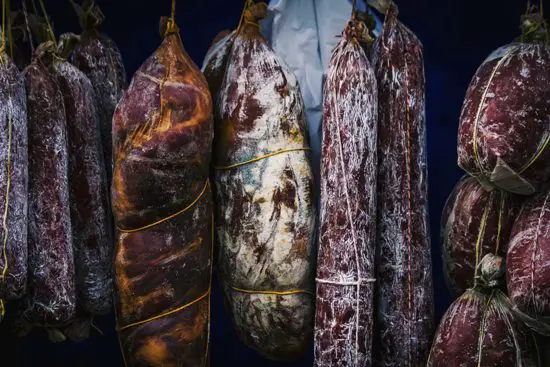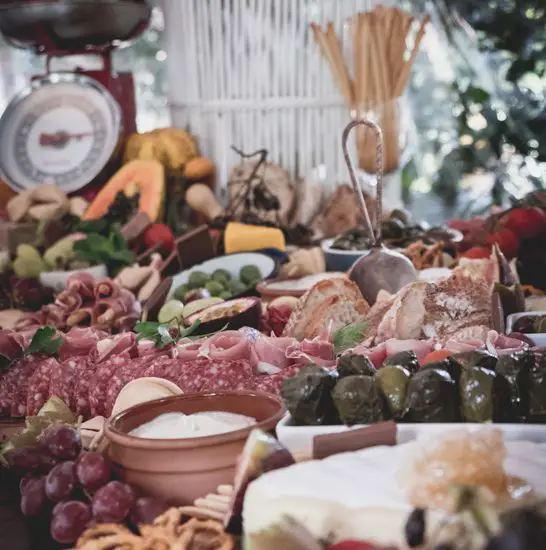Salami is a beloved food item enjoyed by many, especially in Europe and the U.S., with a wide variety of types to choose from.
However, despite its popularity, there are concerns about its safety and whether it is raw or not. This uncertainty can deter some people from consuming salami altogether.
If you’re curious about salami and want to know more about its composition and preparation, keep reading to dispel the myths and gain a better understanding of this delicious food.

Table of Contents
Cooked or Raw? Unraveling the Mystery of Salami’s Preparation Process
Salami may look like raw meat, but it is not entirely uncooked. This cured sausage undergoes a curing process that gives it a marbled appearance resembling raw meat.
Although it starts out raw during the early stages of production, it does not remain that way.
One reason why people may think salami is raw is that it looks like raw sausage, which is made of raw meat and requires cooking.
However, salami and raw sausage share similarities, such as being made of finely chopped or ground meat, spices, and fat, and being stuffed into casings.
Despite the similarities, there are clear differences between the two. Raw sausage is much paler and duller in color than salami.
Some Italian salami variants are cooked or smoked during the manufacturing process to add a specific flavor, such as Cotto salami. Without these procedures, the food is considered raw and not intended for consumption.
Is it Safe to Eat Salami Without Cooking It?

Salami is perfectly safe to eat as it is, straight from the market. The salami you purchase is not raw meat. Whether it’s a traditionally cured meat salami or cooked salami, you can simply slice it and eat it right away without any need for cooking.
It’s worth noting that due to its low moisture content, cured meat such as salami doesn’t fry well. However, cooked salami can be fried with a small amount of oil and has a similar texture to bacon.
Due to the way salami is made, either cured or cooked, this meat will last a long time. If kept in the refrigerator, its shelf life can be prolonged for months, as long as the meat is not contaminated.
If you’re purchasing salami from a deli, and it’s being cut for you on the spot, you should consume it within two weeks at the latest. Otherwise, constant air exposure will alter the flavor.
The Process of Making Salami

Salami production is a three-stage process that includes raw material preparation, fermentation, and drying.
To begin, meat (usually beef or pork) is ground and mixed with various ingredients like spices, sugar, pepper, and yeast. However, the latter two stages are crucial to ensuring the safety of the food.
Fermentation is a critical process that determines the texture, flavor, and safety of the salami. The meat is hung in warm and humid conditions for up to three days, promoting the growth of fermenting bacteria that protect the salami from harmful microorganisms.
Manufacturers then add sugar to feed the curing bacteria, which release the lactic acid that reduces the meat’s water-holding capacity and pH, coagulating the proteins. This process imparts a strong flavor to the salami and makes the food inhospitable to pathogenic bacteria.
After fermentation, salami is dried, which forms a hard shell on its surface, decreases the risk of spoilage and disease, and minimizes permeability. A white coating of either mold or flour helps deter oxidation and fat rancidity.
Curing salts like nitrites or nitrates can also be added to prevent contamination by bacteria and provide extra color.
When combined with salt, acidity, and dryness, fully cured salami is safe to eat.
>>Why does my salami have black spots? Read here; and Difference between Salami and Pepperoni here.
FAQs
Is it Safe to Eat Cold Salami?
Eating cold salami is a safe and common practice. The process of drying and curing salami is specifically designed to turn fresh meat into a preserved food item that can last for months without the need for refrigeration or freezing.
Is Pre-Cooked Salami Available in the Market?

Finding pre-cooked salami may be challenging, as these types are not common.
Cooked salami usually has a paler color and a softer, springier texture compared to traditional, dried salami.
Unlike dried salami, cooked salami is not dried, making it appear larger and more prone to developing mold due to its higher moisture content.
Despite being cooked, these salami types are still salted and spiced like regular salami, which contributes to their extended shelf life.
What Distinguishes Cured Salami from Uncured Salami?
Cured and uncured salami differ in their preservation methods.
Uncured salami uses natural curing substances, while cured salami relies on additives and chemicals.
Uncured salami has a paler color and a different flavor profile due to the absence of curing.
However, both types still contain nitrates, with uncured salami deriving them from natural sources like celery or beets.
Sodium nitrites in cured salami are in the form of artificial substances.
How to Consume Uncured Salami?
Uncured salami can be consumed either cooked or raw and contains similar preservation substances to its cured counterpart to ensure safety.
Properly stored in the freezer, uncured salami can remain safe to eat for up to two months while maintaining its peak quality.
Conclusion
Can you eat salami raw? – Yes, you can eat salami raw as it undergoes a stringent production process to prevent harmful microbes.
However, if you prefer, you can also cook or fry salami to enhance its flavor. It’s essential to consume salami in moderation to avoid putting unnecessary strain on your body.

Fernando is the creator and writer behind the food blog Eating with your Hands. Living and working in cities like Paris, Barcelona, and Berlin, and being married to a Canadian foodie, has given Fernando a passion and interest in food and inspired him to run EWYH.
